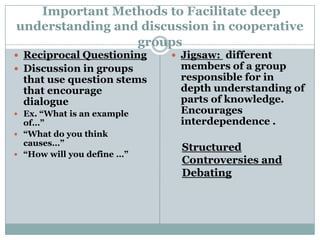
343%20 learner%20differences%20and%20learning%20needs1
- 1. Important Methods to Facilitate deep understanding and discussion in cooperative groups Reciprocal Questioning Jigsaw: different Discussion in groups members of a group that use question stems responsible for in that encourage depth understanding of dialogue parts of knowledge. Ex. “What is an example Encourages of…” interdependence . “What do you think causes…” Structured “How will you define …” Controversies and Debating
- 2. Guidelines Using Cooperative Learning Page 332 in Textbook.
- 3. Different COGNITIVE Theories favor Cooperative Learning for different Reasons PIAGET VYGOTSKY IPMODEL
- 4. Cognitive Theories The more the learner is cognitively engaged the more he/she is likely to learn. VYGOTSKY -The co- PIAGET - The construction of Construction of knowledge – the knowledge - conflict and internalization of socially disequilibrium shared knowledge IPMODEL – Group help individual’s rehearse, practice , expand knoweldge Learner’s Motivation
- 5. The Concept of Motivation An internal state that arouses, directs, and maintains behavior. INTRINSIC EXTRINSIC MOTIVATION MOTIVATION ASSOCIATED WITH ASSOCIATED WITH ACTIVITIES THAT EXTERNAL ARE THEIR OWN FACTORS. REWARD.
- 6. COGNITIVE APPROACHES TO MOTIVATION Intrinsic motivation where behavior is determined by our thinking. Active Learners who seek autonomy and self- determination.
- 7. Learner Differences and Learning Needs CHDV
- 8. Learner’s differences The Concept of Individual Differences Intelligence and the Law
- 9. THE CONCEPT OF INTELLIGENCE DO PEOPLE VARY IN WHAT WE CALL INTELLIGENCE? The Content of Intelligence The Stanford-Binet Test THE NATURE-NURTURE DEBATE Is intelligence due to heredity or environment?
- 10. Intelligence: One ability or many? Charles Spearman (1927) The most widely One mental attribute is accepted view of responsible for intelligence today, is that performance on all intelligence has many cognitive and social facets and includes many tasks. general abilities at the g-general intelligence top and specific abilities at he bottom.
- 11. Multiple Intelligence Gardner (1983) Guilford (1988) (1) A theory of at least eight multiple intelligences. (2) A biopsychological concept.
- 12. Howard Gardner Logical-mathematical Linguistic Musical Spatial Bodily-kinesthetic Interpersonal Intrapersonal Naturalist (Table 4.1, p.116)
- 13. Gardner on Intelligence “ My work is very critical of what I call the “dipstick theory”, which is the notion that everybody is born with a certain amount of intelligence and it doesn’t matter where or when you live, how much stuff you have will show. I think we are built with different kinds of potentials, and whether they get realized depends on what’s available in society.”
- 14. INTELLIGENCE AS A PROCESS Rather than describing how individuals are different in the CONTENT of intelligence, recent work attempts to describe the thinking PROCESSES that are common to all people. How do humans gather and use information to solve problems and behave intelligently?
- 15. Robert Sternberg (2004) TRIARCHIC THEORY OF INTELLIGENCE ANALYTIC INTELLIGENT BEHAVIOR IS THE PRODUCT OF CREATIVE APPLYING THINKING STRATEGIES, HADLING NEW PROBLEMS SUCCESSFULLY AND PRACTICAL ADAPTING BEHAVIOR TO NEW CONTEXTS.
- 16. Educational Implications The Nature-Nurture Debate: INTELLIGENCE IS A CURRENT STATE OF AFFAIRS AFFECTED BY PAST EXPERIENCE AND OPEN TO FUTURE CHANGES. Cognitive Skills are always improvable Intelligence Scores and Achievement : ACADEMIC ACHIEVEMENT and LIFE ACHIEVEMENT
- 17. ABILITY DIFFERENCES AND TEACHING CLASS IS FORMED CLASS IS FORMED BASED ON ABILITY BASED ON TRACKING DIFFERENTIAL WITHIN-CLASS ABILITY ABILITIES GROUPING UNTRACKING The Issue of whether tracking is an effective strategy is controversial Strengths: (i)Average and high-ability students lose 2-5% points in achievement in untracking groups, (ii)the phenomenon of bright flight. Weaknesses: (i) Tracking increases the gap between high and lower achievers, (ii) The effects of labeling on cognitive performance, (iii) Diversity Issues – Low Income families and certain cultures are overrepresented in the lower tracks.
- 18. TWO ALTERNATIVE SOLUTIONS WITHING CLASS GROUPING FLEXIBLE GROUPING Reading Students are Math continuously grouped and re-grouped based Deals with differences in on their specific students’ prior learning. learning needs for the No clear evidence that specific activity. this method is superior. Cooperative teaching.
- 19. The Individual with Disabilities Education Improvement Act (IDEA) Revised 1990, 1997, 2004 The State should provide a FREE and APPROPRIATE public education for all students with disabilities who participate in special education. Section 504 (Civil Rights Law ) prevents discrimination against students with disabilities. Three Implications of IDEA (1) The Individualized Education Program (2) The Rights of Students and Families (Zero reject) (3) The Least Restrictive environment (educating each child with peers in the regular classroom to the greatest extent possible).
- 20. IDEA 1. About 10%of all 2. The aim : According to students aged 6 through their disability = In 21, receive special general education classes education services. for at least 40% of their school day.
- 21. Study TABLE 4.4 page 125 Disability No of Students in 2000-2001 Specific Learning D. 2,887.217 OVERALL 5,775,722
- 22. Reading the Table Most Prevalent Problems Attention-Deficit Hyperactivity Disorder Communicative Disorders Students with intellectual, behavioral and/or emotional problems Less Prevalent Problems Health Impairments Autism Cerebral Palsy /Epilepsy Vision and Hearing Impairments
- 23. Specific Learning Disabilities About one half of all students receiving some kind of special education service are diagnosed as having learning disabilities. A relative new term which does not have a fully agreed upon definition. “a disorder in one or more basic psychological processes…” (IDEA) “disorders of learning and cognition that are intrinsic to the individual” (Special Education Report).